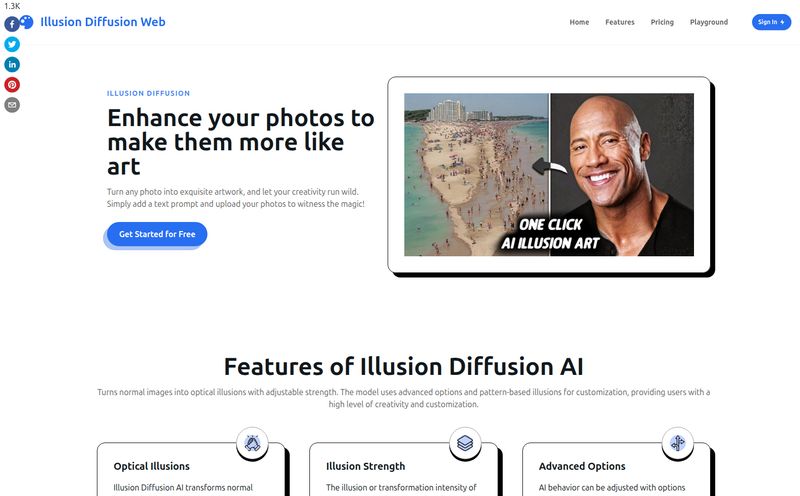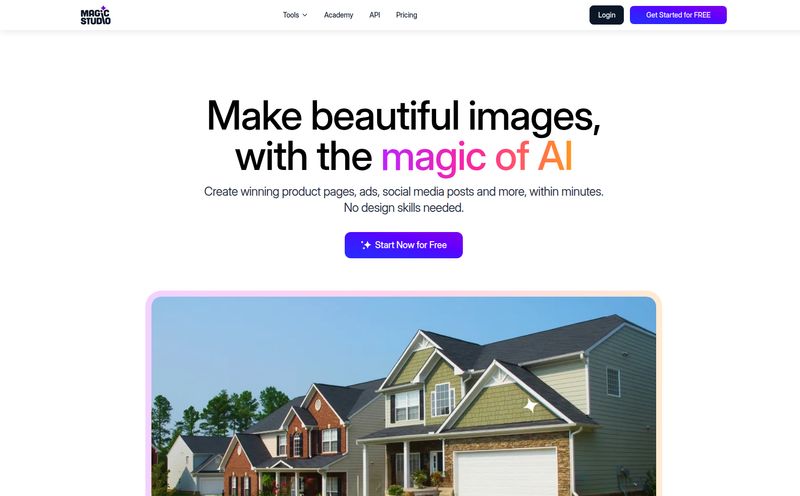As someone who’s been swimming in the digital marketing and SEO pool for years, I've seen a lot of online tools. They pop up like mushrooms after a rainstorm. Most of them promise the world, ask for your email, your credit card, your firstborn, and then deliver a clunky, ad-riddled experience. So, when a tool like PhotoEnlarger.com slides across my screen, my internal skeptic-o-meter goes haywire. Its claim? Enlarge your photos, even with AI, for free. No signup. No catch. And get this—it's private.
Yeah, right. That’s what they all say. But I’m always game to be proven wrong. I've lost count of the number of times I've found the perfect image for a blog post, only to discover it's a measly 300 pixels wide. Useless. The idea of a quick, free fix is... well, it's the holy grail for content creators. So, I rolled up my sleeves, grabbed a few low-res images I had lying around, and decided to see if this thing was legit or just another digital ghost.
So, What Exactly is This PhotoEnlarger Gizmo?
At its heart, PhotoEnlarger.com is a specialist. It’s not trying to be the next Photoshop or Canva. It does one primary thing: it makes small pictures bigger. Think of it less like a sprawling creative suite and more like a single, high-quality magnifying glass in your digital toolkit. You pop a photo in, and it gives you a bigger version back, trying its best to keep things from turning into a pixelated mess.
But here’s the bit that really got my attention, the part that separates it from so many others. It all happens in your browser. This isn't just a technical detail; it's a huge deal for privacy. Your photo never gets uploaded to their servers. It’s like having a private darkroom right on your computer. Your embarrassing family photos or sensitive client mockups stay right where they belong: with you. In an age where our data is the product, that’s a massive, massive plus in my book.

Visit PhotoEnlarger.com
The Different Flavors of Enlargement
Most tools give you one-size-fits-all solution. PhotoEnlarger gives you a menu. It runs six different algorithms, which is pretty cool because not all images are created equal. You get a choice, and that shows a certain respect for the user's needs.
The Traditional Methods
You’ve got your classic algorithms here—names like Lanczos 3 and Hermite. These are the old-school workhorses of image resizing. They’re basically very clever mathematical ways of stretching an image and filling in the new pixels based on the surrounding ones. For certain things, like graphics or illustrations with sharp lines, they can work surprisingly well. They're fast, predictable, and get the job done without much fuss. Nothing to write home about, but solid.
The AI in the Room: ESRGAN
And then there's the main event: ESRGAN. This is the Artificial Intelligence option. ESRGAN, which stands for Enhanced Super-Resolution Generative Adversarial Network (say that five times fast), is a different beast entirely. It doesn't just stretch the pixels; it looks at the image and imagines the missing details. It's been trained on millions of images to understand what a high-resolution version of a low-resolution texture should look like. The results can be... startling. It can sometimes pull details out of a blurry mess that you wouldn't think were there. It's the difference between blowing up a balloon and actually adding more air to it.
Let’s Talk About That Little Word: Privacy
I touched on this, but I want to hammer it home. The client-side processing of PhotoEnlarger.com is its killer feature. Seriously. Every time you upload a photo to a free online editor, you're essentially handing over a copy. Best case scenario? It gets deleted after a while. Worst case? It's sitting on a server that gets breached, or the terms of service you scrolled past allow them to use it for training their own AI models. With this tool, that entire conversation is moot. Your photo is processed by your computer's power and then saved back to your computer. It’s a closed loop. For anyone working with proprietary images or who simply values their privacy, this is a non-negotiable benefit.
My Honest-to-Goodness Test Drive
I decided to try it with a classic low-res problem: a headshot from an old blog post that I needed to repurpose. The original was a grainy 250x250. I dragged and dropped it onto the site. Simple enough.
The interface is... basic. No frills, no fancy animations. Just a box and a button. I appreciate that. I chose the ESRGAN (AI) option and set it to enlarge by 400%. The site gives you a little warning:
The ESRGAN algorithm can be slow... please be patient.
They aren’t kidding. My browser's fan spun up, and for a good 30-40 seconds, it was thinking. Hard. This isn't a knock, just a reality of asking your own machine to do heavy AI lifting. The final result? Impressive. Not perfect—AI can sometimes produce slightly strange textures if you look really close—but the new 1000x1000 image was crisp, clear, and totally usable. It was miles better than what a standard resize would have produced.
The Good, The Bad, and The Kinda Blurry
So, after playing around with it for a while, here’s my breakdown. No tool is perfect, not even a free one. It's all about whether its strengths align with your needs and its weaknesses are deal-breakers.
For me, the biggest advantages are obvious. It's completely free, with no hidden costs or credit systems. The privacy-first approach is a godsend and something more services should copy. Having multiple algorithms, especially a powerful AI like ESRGAN, gives you flexibility you rarely find in free tools. And its dead-simple interface means anyone can use it in seconds. No learning curve required.
On the flip side, there are some limitations to be aware of. That ESRGAN algorithm, while powerful, can feel slow on older machines or with very large images. The tool is also entirely dependent on your browser's performance, so your experience on a high-end desktop will be different from that on a cheap laptop. And finally, its a one-trick pony. You can enlarge and do a basic crop, and that's it. Don't come here looking for filters, text overlays, or advanced color correction. It's not that kind of party.
Who Is This Tool Actually For?
This isn't for the professional photographer who lives in Adobe Lightroom. This is for the rest of us. It's for the blogger who needs to upscale a featured image. It's for the student who needs a bigger diagram for their slideshow. It’s for the social media manager who was sent a potato-quality logo from a client. It's for anyone who has ever muttered, "I wish this picture was just a little bit bigger" and didn't want to spend 30 minutes or 30 dollars to fix it. It's a quick, efficient, and trustworthy utility. A digital pocketknife.
Frequently Asked Questions
1. Is PhotoEnlarger.com really, truly free?
Yes. I clicked everything. I looked for hidden pages. There's no pricing, no sign-up, no credit packs. It's supported by ads, but it's free to use as much as you want.
2. How do I know my photos are safe and private?
Because the entire enlargement process happens locally on your computer (client-side). Your image file is never uploaded to their website's server, which is the gold standard for privacy with online image tools.
3. Which enlargement algorithm should I choose?
For most real-world photos of people, nature, or objects, start with the esrgan (AI) option. It generally gives the best results. For pixel art, logos, or simple graphics, one of the traditional methods like 'Nearest neighbor' might actually produce a cleaner result.
4. Can I use PhotoEnlarger on my phone or tablet?
Yes, you can. Since it's a website, it works in any modern browser on any device. However, keep in mind that the AI algorithm is resource-intensive, so it might be significantly slower on a mobile device compared to a desktop computer.
5. Are there any limits on the size or type of image I can upload?
The tool works with common formats like JPG, PNG, etc. While there are no explicit hard limits mentioned, performance will depend on your device's memory and processing power. Trying to 4x a massive 20MB image might crash your browser tab, so be reasonable!
My Final Verdict on PhotoEnlarger
In a world of freemium models and data-hungry platforms, PhotoEnlarger.com is a refreshingly honest and effective tool. It knows exactly what it is: a simple, powerful way to make your pictures bigger without compromising your privacy or your wallet. It's not flashy. It won't make you a gourmet coffee. But when you need a bigger picture, it delivers.
It has its quirks, sure, like teh occasional slowness of the AI. But its strengths—being free, private, and surprisingly capable—far outweigh them. It has officially earned a permanent spot in my 'Quick SEO Tools' bookmark folder, and I suspect it might just earn a spot in yours, too.
Reference and Sources
- PhotoEnlarger.com Official Website
- ESRGAN: Enhanced Super-Resolution Generative Adversarial Networks (The original research paper for the technically curious)



